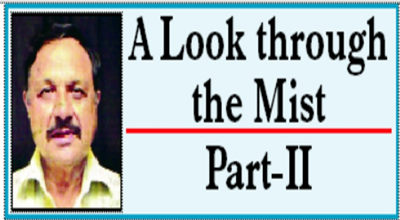Insertions made in the text of Preamble of Constitution don’t violate “Doctrine of Basic Structure of COI
But are amendments to Art 74 of COI by 42nd & 44rth Acts of 1976 &1978 with in”Basic Structure Doctrine” ?
Kesavananda Bharti case 13 Judge Constitution Bench Judgement had unfolded “Doctrine of Basic Structure” in 1973

Daya Sagar
Even Art 368 has been amended , First < Constitution (Twenty-fourth Amendment) Act, 1971 s3 where under “Procedure for amendment of the Constitution” was substituted with the text Power of Parliament to amend the Constitution and procedure therefor , (w.e.f. 5-11-1971); Clause- 1 inserted bys3 ; Art. 368 re-numbered as cl. (2) thereof by s. 3, ibid. (w.e.f. 5-11-1971; Clause -3 was added ” Nothing in article 13 shall apply to any amendment made under this Article ” inserted by the Constitution (Twenty-fourth Amendment) Act, 1971, s. 3 (w.e.f. 5-11-1971). Second vide s 55 of the Constitution (Forty-second Amendment) Act, 1976, s. 55 (w.e.f. 3-1-1977) were . added Section 4 { No amendment of this Constitution (including the provisions of Part III) made or purporting to have been made under this article [whether before or after the commencement of section 55 of the Constitution (Forty-second Amendment) Act, 1976)shall be called in question in any court on any ground} and Section-5 (For the removal of doubts, it is hereby declared that there shall be no limitation whatever on the constituent power of Parliament to amend by way of addition, variation or repeal the provisions of this Constitution under this article.) but Section-4 has been declared invalid by the Supreme Court in Minerva Mills Ltd. and Others Vs. Union of India and Others 1980 where Section -4 has been held valid interms of doctrine of basic structure of Constitution. Similarly Art 74 (1st edition 1949 Art-74 said <” {Art- 74(1) There shall be a Council of Ministers with the Prime Minister at the head to aid and advise the President in the exercise of his functions. (2) The question whether any, and if so what advice was tendered by Ministers to the President shall not be inquired into in any court.”>) of the constitution of India has been amended two times First 42nd Amendment Act of 1976 and Second vide 44rth Amendment Act of 1978 ( The text <” There shall be a Council of Ministers with the Prime Minister at the head to aid and advise the President in the exercise of his functions”> has been replaced by <” (1) There shall be a Council of Ministers with the Prime Minister at the head to aid and advise the President who shall, in the exercise of his functions, act in accordance with such advice: [Provided that the President may require the Council of Ministers to reconsider such advice, either generally or otherwise, and the President shall act in accordance with the advice tendered after such reconsideration. > ) where under the authority / status of President of India as preserver, protector and defender of constitution in terms Oath taken by President under Art 60 ( Original Art-60 < – “I, A.B., do swear in the name of God that I will faithfully execute the office solemnly affirm of President (or discharge the functions of the President) of India and will to the best of my ability preserve, protect and defend the Constitution and the law and that I will devote myself to the service and well-being of the people of India.” > ) has been very much “diluted” since President after that has to act only as per the advice of Council of Ministers where as in the original article President was not obliged to necessarily go only by the advice of the Council of Ministers but had the capacity to over rule even the parliament in case there were fears of damage to the basic structure of COI. Such like amendments surely are against the doctrine of basic structure of Constitution of India. Since the 42nd anad 44rth amendments to Constitution of India involve a big question of the status and authority of the President to perform the role as a part of Parliament of India in terms of Art -79 ( Art 79 <“Constitution of Parliament.-There shall be a Parliament for the Union which shall consist of the President and two Houses to be known respectively as the Council of States and the House of the People”> ) and as a preserver, protector and defender of Constitution of India (Original Art-60 < – “I, A.B., do swear in the name of God that I will faithfully execute the office solemnly affirm of President (or discharge the functions of the President) of India and will to the best of my ability preserve, protect and defend the Constitution and the law and that I will devote myself to the service and well-being of the people of India.” “>) such like amendments surely need review by supreme court of India before any unwanted events against the doctrine of basic structure take birth
Kesavananda Bharti case 13 Judge Bench Constitution Judgement professed and held that although all parts of constitution including Fundamental Rights were not out side Parliament’s amending power, the “basic structure” of the Constitution can not be distorted even by a constitutional amendment. Hence the Judiciary can strike down any amendment made by Parliament that is against / in conflict with the ” basic structure” of Constitution which has been the spirit of the judgement in Minerva mills case (1980) using the Basic Structure doctrine where inserting Section -4 in Art 368 by constitution amendment was held invalid. Although the Kesavananda Bharti case 13 Judge Constitution Bench Judgment had not provided any relief in favour of the petitioner but had unfolded the Doctrine of Basic Structure of Constitution of India.
(The author is a Sr Journalist & analyst of J&K Affairs).
